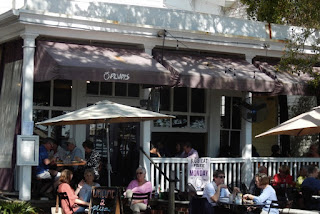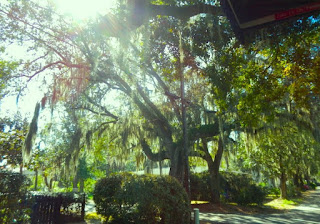Beaufort, established in 1711, is the second oldest city in South Carolina and predates the founding of the US by sixty-five years. It is situated in the Lowcountry on Port Royal Island along the Atlantic shore. By virtue of its age and location it has been a participant and a witness to the events that shaped our country. To interpret those stories it offers seventy sites listed on the National Register of Historic Places, the largest Gullah community, an unparalleled number of architectural treasures dating from the antebellum period, award-winning cultural and hi
No matter how you choose to experience Beaufort you should begin in the 7-acre Henry C. Chambers Waterfront Park and the adjacent Downtown Marina. There are historic markers and views of the inner coastal waterway. The area is in close proximity to Downtown Bay Street, on the National Register, filled with unique shops, galleries and eclectic restaurants. Sea Island Carriage Tours is located on Bay Street and this 55-minute, leisurely paced, narrated tour provides an excellent overview of the city. seaislandcarriagecompany.com
Plum’s Restaurant on Bay Street offers Lowcountry cuisine crafted from fresh locally sourced foods. The dining is casual but the food is really serious! Plumsrestaurant.com
While on the waterfront a great place to dine is the Saltus River Grill. The views are outstanding and the menu provides a seafood culinary experience. Saltusrivergrill.com
Movie fans can tour Hollywood movie locations on a walking tour and on the Pat Conroy Literary Tour. Conroy, author of The Great Santini, lived in Beaufort and included on a tour of sites important to the author is the Pat Conroy Literary Center. The guided van tour is 90-minutes.
The Milton Maxcy house was built on the site of a 1740s house in 1810 and remodeled in 1850. The palatial Greek Revival home is known as the Secession House because it was there that meetings, as early as 1851, were held that led to the decision to favor secession. The owner at the time, Edmund Rhett, a rabid secessionist, enslaved 42 people.
Prior to the Civil War South Carolina was the richest colony in the nation due to its succeeding eras of deerskin, indigo, rice and cotton trades. The first colonial settlers arrived from Barbados in 1690 with their slaves. It quickly became apparent that slavery was very lucrative and by 1860 they were 57% of the state’s population. Lowcountry plantation owners flaunted their wealth by building elaborate summer homes in Beaufort, many of which still stand and are today a Landmark District. The Nov. 7, 1861 Battle of Port Royal led to early Union occupation of Beaufort. When the Union soldiers marched in in December the sole remaining white resident was in the post office and was informed that no harm would come to the town.
In January of 2017 President Obama established the Reconstruction Era National Monument in Beaufort to recognize, commemorate and promulgate the impact of the Reconstruction Era, from 1861-76, on world history. Beaufort was chosen largely because of the Port Royal Experiment, a first step toward reconstruction. The visitor center houses an exhibit that provides a general overview. Additional sites are found at the Penn Center, Camp Saxon and within the historic district. nationalparks.org/explore-parks/reconstruction-era-national-monument
The Union was left with an empty town and more than 10,000 abandoned slaves, arguably the first freed slaves in the war. By 1862 missionaries, many from Philadelphia, arrived. The US government permitted the freedmen to continue to run the plantations with profits given to the government. Many of the federal taxes on Beaufort homes went unpaid and they were sold at auction. Some were purchased by the formerly enslaved. One case, in which the home was purchased by the former black housekeeper, went to the Supreme Court. The former owner lost the case.
Beaufort History Museum, located in the arsenal, relates the story of Beaufort from the 1500s. On the second level a gallery is devoted to movies filmed in the area. The history gallery has an impressive array of artifacts and offers guided tours. www.beauforthistorymuseum
Robert Smalls was born John McKee’s slave in Beaufort in 1839. McKee took him to Charleston in 1851 and hired him out. He eventually worked on the Confederate troop ship CSS Planter where he became capable of doing every job. While the white crew was ashore on May 13, 1862 he loaded the ship with his family and other black crewmen and their families, dressed as the captain and sailed the ship through Charleston Harbor. He turned the ship over to the Union and received a $1500 bounty and heroic status in the North. He was promoted to captain of the gunboat Planter in 1863. Also in 1863 he met with Lincoln to discuss the fate of the contrabands. In 1868 he attended the State Constitution Convention. He served in the State Legislature 1868-74 and the House of Representatives from 1875-1887.
His home, a T-shaped 2-story house on Prince Street, was McKee’s former home. When his master’s wibecame ill Smalls moved her into the mansion. His family retained ownership until 1953.
Smalls died in 1915 and was interred in a family plot at the 1863 Tabernacle Baptist Church. A memorial to Smalls is on the grounds and will be joined by a life-sized statue of Harriet Tubman who served as a nurse in Beaufort.
The Beaufort Inn provides perfect accommodations for a visit to the Hammock Coast. The boutique inn is located on a private city block and includes both mansion and cottage guestrooms with unique and special touches. The amenities include private porches, breakfast vouchers, evening snacks, marshmallow roasts and deluxe bedding and linens. The inn is within walking distance of all the historic district sites and attractions and the Beaufort Day Spa is nearby. www.Beaufortinn.com
Beaufort was named the Best Small Town in the South. After visiting, you will agree. #discoversc



















No comments:
Post a Comment